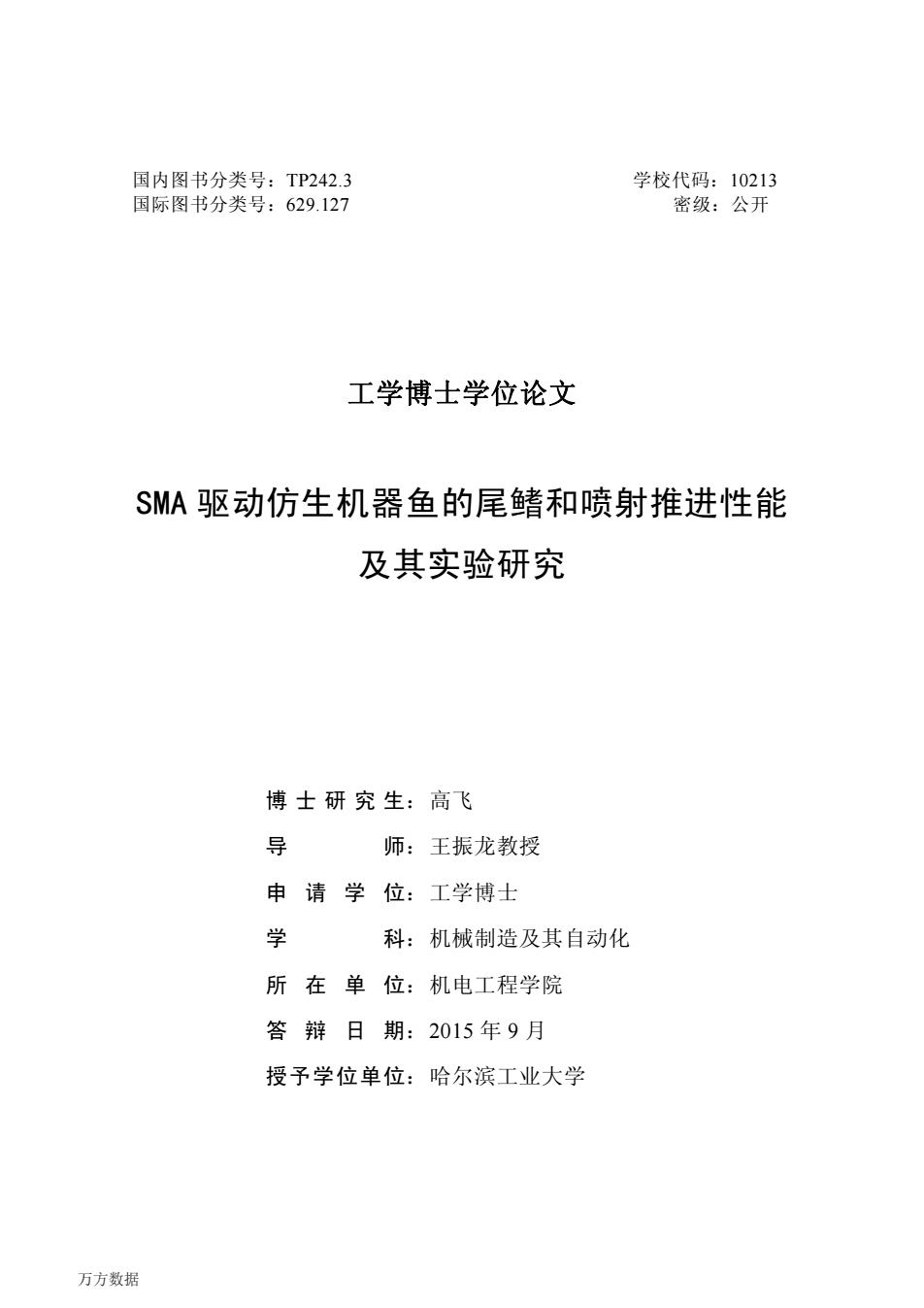
国内图书分类号:TP242.3 学校代码:10213 国际图书分类号:629.127 密级:公开 工学博士学位论文 SMA驱动仿生机器鱼的尾鳍和喷射推进性能 及其实验研究 博士研究生:高飞 导 师:王振龙教授 申请学位:工学博士 学 科:机械制造及其自动化 所在单位:机电工程学院 答辩日期:2015年9月 授予学位单位:哈尔滨工业大学 万方数据
国内图书分类号:TP242.3 学校代码:10213 国际图书分类号:629.127 密级:公开 工学博士学位论文 SMA 驱动仿生机器鱼的尾鳍和喷射推进性能 及其实验研究 博士研究生:高飞 导 师:王振龙教授 申请学位:工学博士 学 科:机械制造及其自动化 所 在 单 位:机电工程学院 答 辩 日 期:2015 年 9 月 授予学位单位:哈尔滨工业大学 万方数据
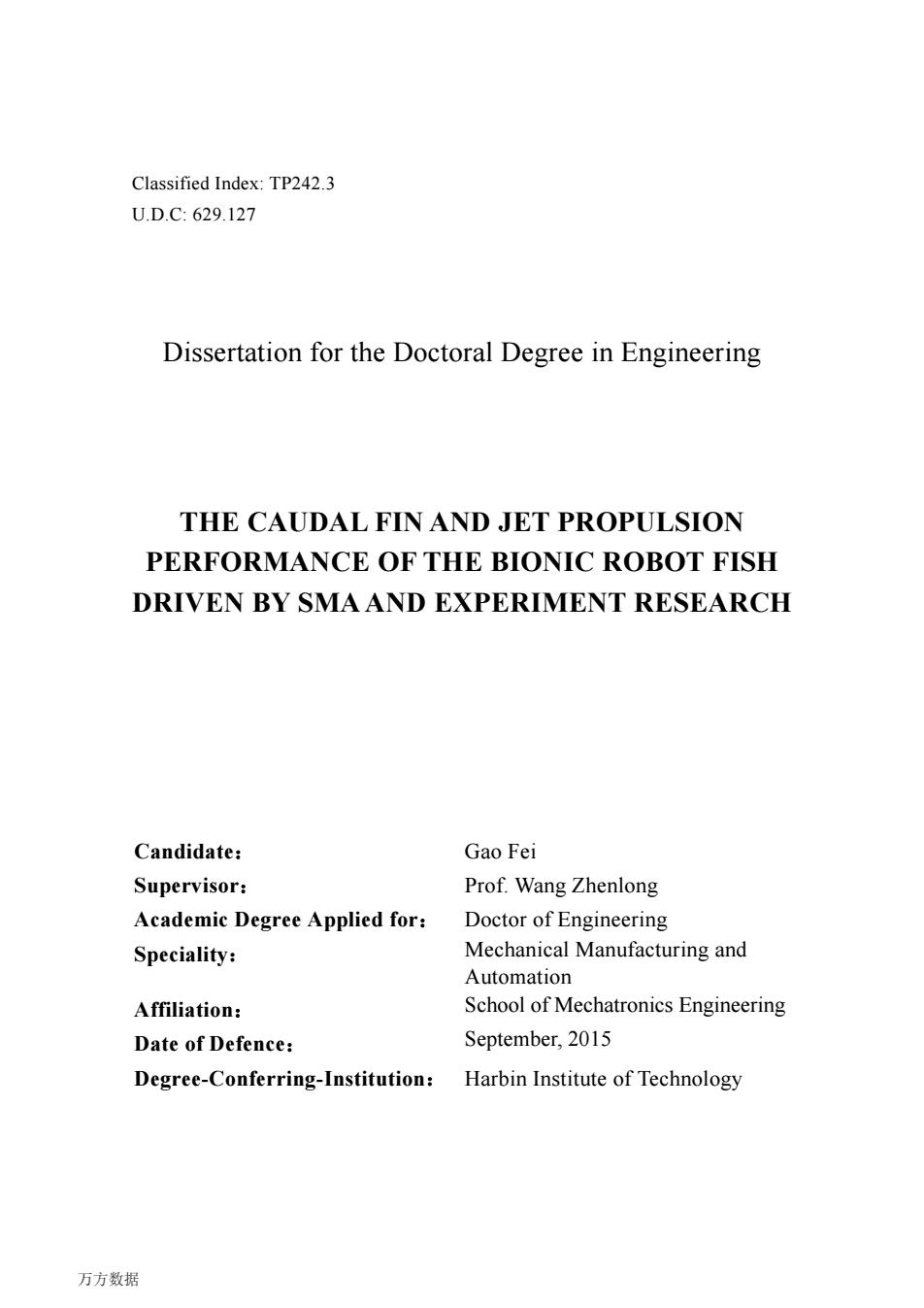
Classified Index:TP242.3 U.D.C:629.127 Dissertation for the Doctoral Degree in Engineering THE CAUDAL FIN AND JET PROPULSION PERFORMANCE OF THE BIONIC ROBOT FISH DRIVEN BY SMA AND EXPERIMENT RESEARCH Candidate: Gao Fei Supervisor: Prof.Wang Zhenlong Academic Degree Applied for: Doctor of Engineering Speciality: Mechanical Manufacturing and Automation Affiliation: School of Mechatronics Engineering Date of Defence: September,2015 Degree-Conferring-Institution: Harbin Institute of Technology 万方数据
Classified Index: TP242.3 U.D.C: 629.127 Dissertation for the Doctoral Degree in Engineering THE CAUDAL FIN AND JET PROPULSION PERFORMANCE OF THE BIONIC ROBOT FISH DRIVEN BY SMA AND EXPERIMENT RESEARCH Candidate: Gao Fei Supervisor: Prof. Wang Zhenlong Academic Degree Applied for: Doctor of Engineering Speciality: Mechanical Manufacturing and Automation Affiliation: School of Mechatronics Engineering Date of Defence: September, 2015 Degree-Conferring-Institution: Harbin Institute of Technology 万方数据
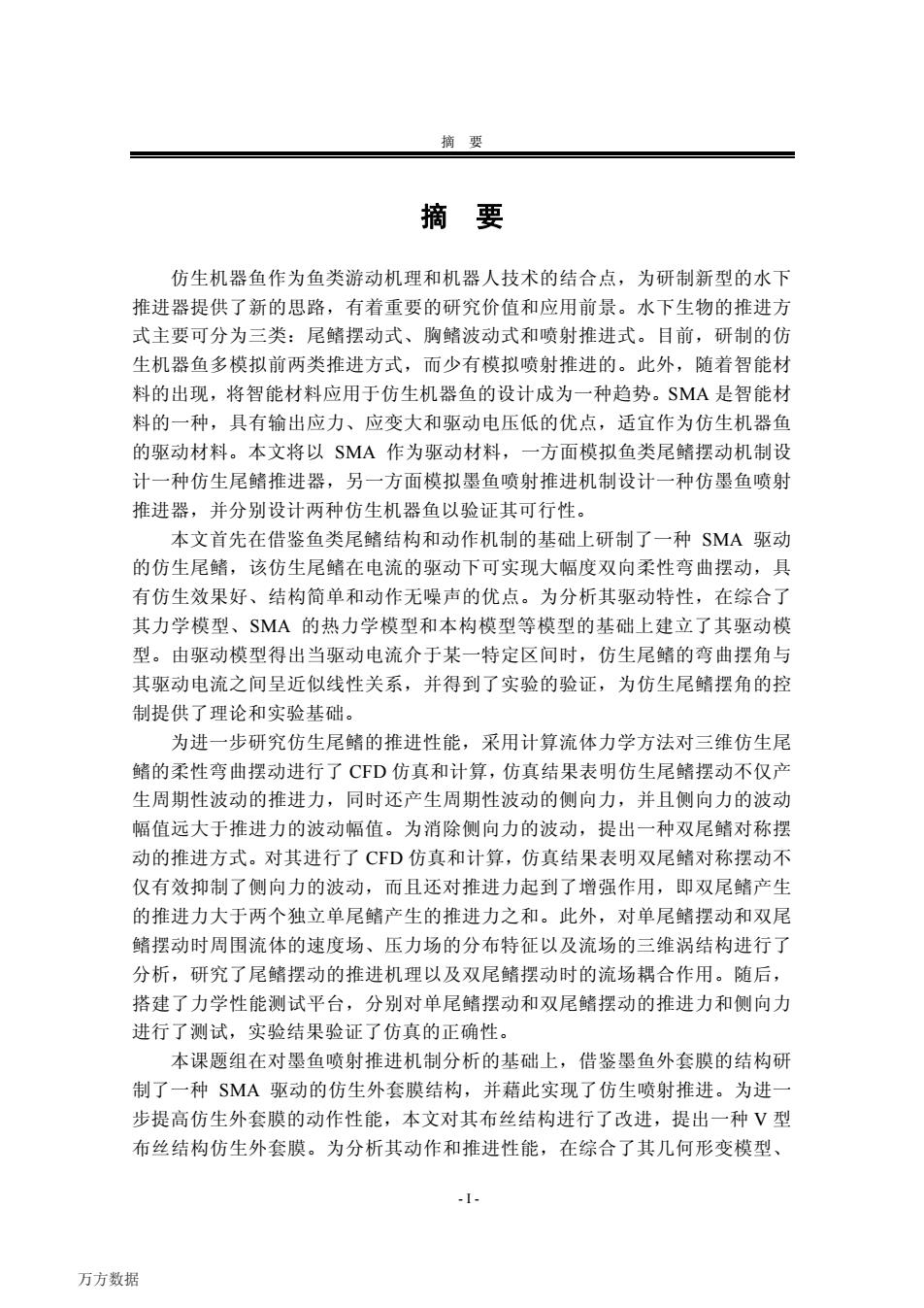
摘要 摘要 仿生机器鱼作为鱼类游动机理和机器人技术的结合点,为研制新型的水下 推进器提供了新的思路,有着重要的研究价值和应用前景。水下生物的推进方 式主要可分为三类:尾鳍摆动式、胸鳍波动式和喷射推进式。目前,研制的仿 生机器鱼多模拟前两类推进方式,而少有模拟喷射推进的。此外,随着智能材 料的出现,将智能材料应用于仿生机器鱼的设计成为一种趋势。SMA是智能材 料的一种,具有输出应力、应变大和驱动电压低的优点,适宜作为仿生机器鱼 的驱动材料。本文将以SMA作为驱动材料,一方面模拟鱼类尾鳍摆动机制设 计一种仿生尾鳍推进器,另一方面模拟墨鱼喷射推进机制设计一种仿墨鱼喷射 推进器,并分别设计两种仿生机器鱼以验证其可行性。 本文首先在借鉴鱼类尾鳍结构和动作机制的基础上研制了一种SMA驱动 的仿生尾鳍,该仿生尾鳍在电流的驱动下可实现大幅度双向柔性弯曲摆动,具 有仿生效果好、结构简单和动作无噪声的优点。为分析其驱动特性,在综合了 其力学模型、SMA的热力学模型和本构模型等模型的基础上建立了其驱动模 型。由驱动模型得出当驱动电流介于某一特定区间时,仿生尾鳍的弯曲摆角与 其驱动电流之间呈近似线性关系,并得到了实验的验证,为仿生尾鳍摆角的控 制提供了理论和实验基础。 为进一步研究仿生尾鳍的推进性能,采用计算流体力学方法对三维仿生尾 鳍的柔性弯曲摆动进行了C℉D仿真和计算,仿真结果表明仿生尾鳍摆动不仅产 生周期性波动的推进力,同时还产生周期性波动的侧向力,并且侧向力的波动 幅值远大于推进力的波动幅值。为消除侧向力的波动,提出一种双尾鳍对称摆 动的推进方式。对其进行了CFD仿真和计算,仿真结果表明双尾鳍对称摆动不 仅有效抑制了侧向力的波动,而且还对推进力起到了增强作用,即双尾鳍产生 的推进力大于两个独立单尾鳍产生的推进力之和。此外,对单尾鳍摆动和双尾 鳍摆动时周围流体的速度场、压力场的分布特征以及流场的三维涡结构进行了 分析,研究了尾鳍摆动的推进机理以及双尾鳍摆动时的流场耦合作用。随后, 搭建了力学性能测试平台,分别对单尾鳍摆动和双尾鳍摆动的推进力和侧向力 进行了测试,实验结果验证了仿真的正确性。 本课题组在对墨鱼喷射推进机制分析的基础上,借鉴墨鱼外套膜的结构研 制了一种SMA驱动的仿生外套膜结构,并藉此实现了仿生喷射推进。为进一 步提高仿生外套膜的动作性能,本文对其布丝结构进行了改进,提出一种V型 布丝结构仿生外套膜。为分析其动作和推进性能,在综合了其几何形变模型、 -I- 万方数据
摘 要 - I - 摘 要 仿生机器鱼作为鱼类游动机理和机器人技术的结合点,为研制新型的水下 推进器提供了新的思路,有着重要的研究价值和应用前景。水下生物的推进方 式主要可分为三类:尾鳍摆动式、胸鳍波动式和喷射推进式。目前,研制的仿 生机器鱼多模拟前两类推进方式,而少有模拟喷射推进的。此外,随着智能材 料的出现,将智能材料应用于仿生机器鱼的设计成为一种趋势。SMA 是智能材 料的一种,具有输出应力、应变大和驱动电压低的优点,适宜作为仿生机器鱼 的驱动材料。本文将以 SMA 作为驱动材料,一方面模拟鱼类尾鳍摆动机制设 计一种仿生尾鳍推进器,另一方面模拟墨鱼喷射推进机制设计一种仿墨鱼喷射 推进器,并分别设计两种仿生机器鱼以验证其可行性。 本文首先在借鉴鱼类尾鳍结构和动作机制的基础上研制了一种 SMA 驱动 的仿生尾鳍,该仿生尾鳍在电流的驱动下可实现大幅度双向柔性弯曲摆动,具 有仿生效果好、结构简单和动作无噪声的优点。为分析其驱动特性,在综合了 其力学模型、SMA 的热力学模型和本构模型等模型的基础上建立了其驱动模 型。由驱动模型得出当驱动电流介于某一特定区间时,仿生尾鳍的弯曲摆角与 其驱动电流之间呈近似线性关系,并得到了实验的验证,为仿生尾鳍摆角的控 制提供了理论和实验基础。 为进一步研究仿生尾鳍的推进性能,采用计算流体力学方法对三维仿生尾 鳍的柔性弯曲摆动进行了 CFD 仿真和计算,仿真结果表明仿生尾鳍摆动不仅产 生周期性波动的推进力,同时还产生周期性波动的侧向力,并且侧向力的波动 幅值远大于推进力的波动幅值。为消除侧向力的波动,提出一种双尾鳍对称摆 动的推进方式。对其进行了 CFD 仿真和计算,仿真结果表明双尾鳍对称摆动不 仅有效抑制了侧向力的波动,而且还对推进力起到了增强作用,即双尾鳍产生 的推进力大于两个独立单尾鳍产生的推进力之和。此外,对单尾鳍摆动和双尾 鳍摆动时周围流体的速度场、压力场的分布特征以及流场的三维涡结构进行了 分析,研究了尾鳍摆动的推进机理以及双尾鳍摆动时的流场耦合作用。随后, 搭建了力学性能测试平台,分别对单尾鳍摆动和双尾鳍摆动的推进力和侧向力 进行了测试,实验结果验证了仿真的正确性。 本课题组在对墨鱼喷射推进机制分析的基础上,借鉴墨鱼外套膜的结构研 制了一种 SMA 驱动的仿生外套膜结构,并藉此实现了仿生喷射推进。为进一 步提高仿生外套膜的动作性能,本文对其布丝结构进行了改进,提出一种 V 型 布丝结构仿生外套膜。为分析其动作和推进性能,在综合了其几何形变模型、 万方数据
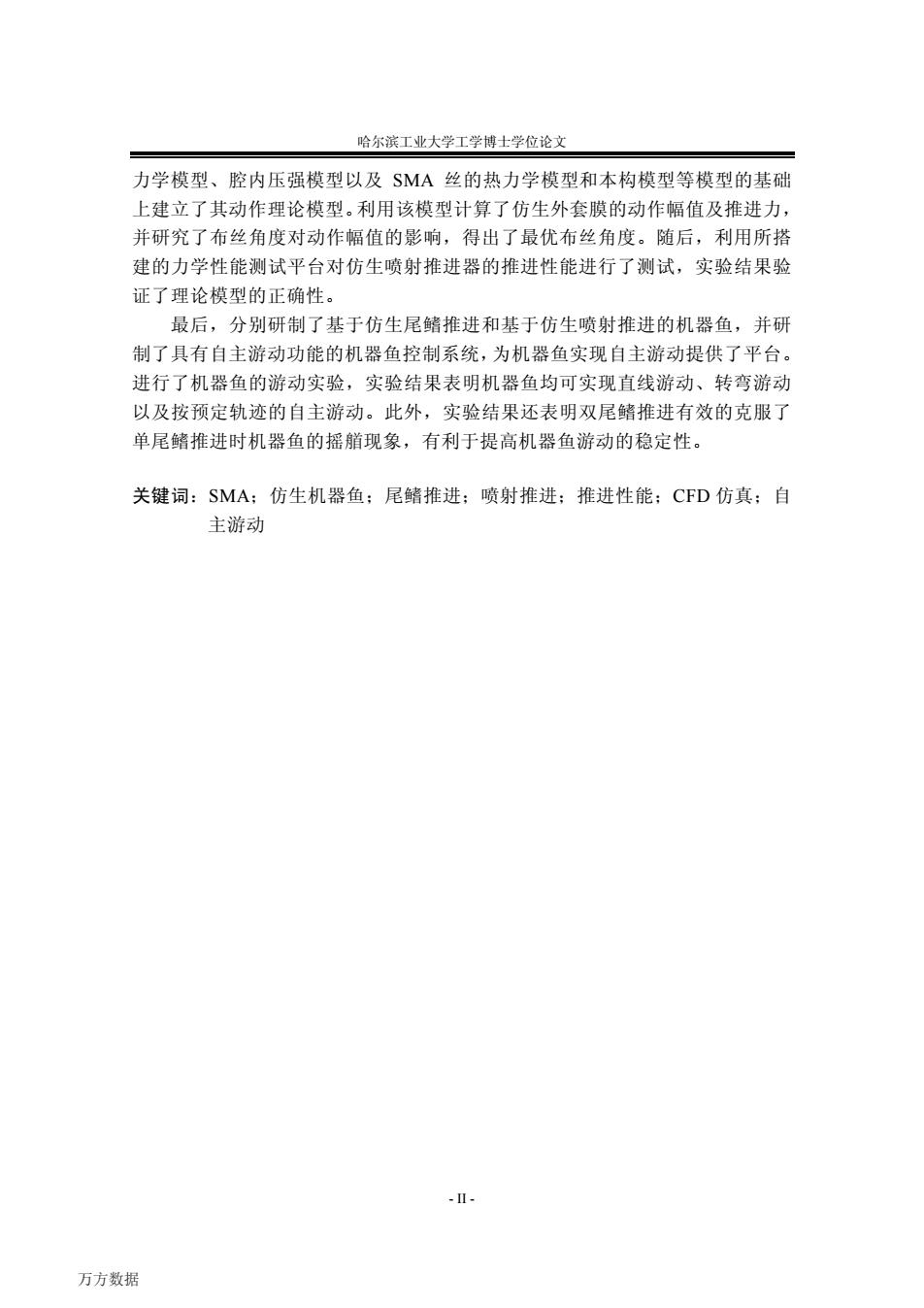
哈尔滨工业大学工学博士学位论文 力学模型、腔内压强模型以及SMA丝的热力学模型和本构模型等模型的基础 上建立了其动作理论模型。利用该模型计算了仿生外套膜的动作幅值及推进力, 并研究了布丝角度对动作幅值的影响,得出了最优布丝角度。随后,利用所搭 建的力学性能测试平台对仿生喷射推进器的推进性能进行了测试,实验结果验 证了理论模型的正确性。 最后,分别研制了基于仿生尾鳍推进和基于仿生喷射推进的机器鱼,并研 制了具有自主游动功能的机器鱼控制系统,为机器鱼实现自主游动提供了平台。 进行了机器鱼的游动实验,实验结果表明机器鱼均可实现直线游动、转弯游动 以及按预定轨迹的自主游动。此外,实验结果还表明双尾鳍推进有效的克服了 单尾鳍推进时机器鱼的摇艏现象,有利于提高机器鱼游动的稳定性。 关键词:SMA:仿生机器鱼:尾鳍推进;喷射推进:推进性能:CFD仿真:自 主游动 -Ⅱ 万方数据
哈尔滨工业大学工学博士学位论文 - II - 力学模型、腔内压强模型以及 SMA 丝的热力学模型和本构模型等模型的基础 上建立了其动作理论模型。利用该模型计算了仿生外套膜的动作幅值及推进力, 并研究了布丝角度对动作幅值的影响,得出了最优布丝角度。随后,利用所搭 建的力学性能测试平台对仿生喷射推进器的推进性能进行了测试,实验结果验 证了理论模型的正确性。 最后,分别研制了基于仿生尾鳍推进和基于仿生喷射推进的机器鱼,并研 制了具有自主游动功能的机器鱼控制系统,为机器鱼实现自主游动提供了平台。 进行了机器鱼的游动实验,实验结果表明机器鱼均可实现直线游动、转弯游动 以及按预定轨迹的自主游动。此外,实验结果还表明双尾鳍推进有效的克服了 单尾鳍推进时机器鱼的摇艏现象,有利于提高机器鱼游动的稳定性。 关键词:SMA;仿生机器鱼;尾鳍推进;喷射推进;推进性能;CFD 仿真;自 主游动 万方数据
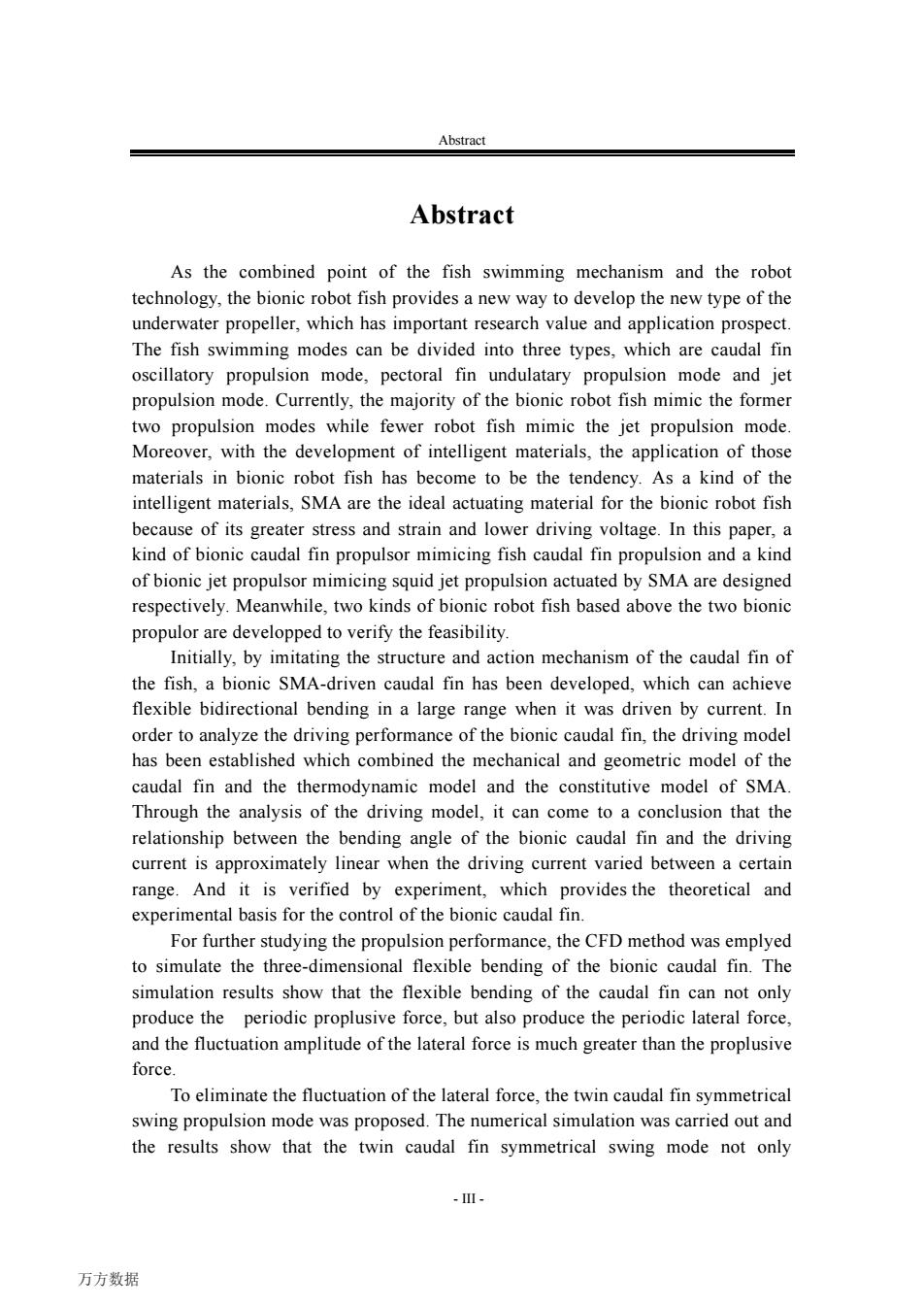
Abstract Abstract As the combined point of the fish swimming mechanism and the robot technology,the bionic robot fish provides a new way to develop the new type of the underwater propeller,which has important research value and application prospect. The fish swimming modes can be divided into three types,which are caudal fin oscillatory propulsion mode,pectoral fin undulatary propulsion mode and jet propulsion mode.Currently,the majority of the bionic robot fish mimic the former two propulsion modes while fewer robot fish mimic the jet propulsion mode Moreover,with the development of intelligent materials,the application of those materials in bionic robot fish has become to be the tendency.As a kind of the intelligent materials,SMA are the ideal actuating material for the bionic robot fish because of its greater stress and strain and lower driving voltage.In this paper,a kind of bionic caudal fin propulsor mimicing fish caudal fin propulsion and a kind of bionic jet propulsor mimicing squid jet propulsion actuated by SMA are designed respectively.Meanwhile,two kinds of bionic robot fish based above the two bionic propulor are developped to verify the feasibility. Initially,by imitating the structure and action mechanism of the caudal fin of the fish,a bionic SMA-driven caudal fin has been developed,which can achieve flexible bidirectional bending in a large range when it was driven by current.In order to analyze the driving performance of the bionic caudal fin,the driving model has been established which combined the mechanical and geometric model of the caudal fin and the thermodynamic model and the constitutive model of SMA. Through the analysis of the driving model,it can come to a conclusion that the relationship between the bending angle of the bionic caudal fin and the driving current is approximately linear when the driving current varied between a certain range.And it is verified by experiment,which provides the theoretical and experimental basis for the control of the bionic caudal fin. For further studying the propulsion performance,the CFD method was emplyed to simulate the three-dimensional flexible bending of the bionic caudal fin.The simulation results show that the flexible bending of the caudal fin can not only produce the periodic proplusive force,but also produce the periodic lateral force, and the fluctuation amplitude of the lateral force is much greater than the proplusive force. To eliminate the fluctuation of the lateral force,the twin caudal fin symmetrical swing propulsion mode was proposed.The numerical simulation was carried out and the results show that the twin caudal fin symmetrical swing mode not only -I- 万方数据
Abstract - III - Abstract As the combined point of the fish swimming mechanism and the robot technology, the bionic robot fish provides a new way to develop the new type of the underwater propeller, which has important research value and application prospect. The fish swimming modes can be divided into three types, which are caudal fin oscillatory propulsion mode, pectoral fin undulatary propulsion mode and jet propulsion mode. Currently, the majority of the bionic robot fish mimic the former two propulsion modes while fewer robot fish mimic the jet propulsion mode. Moreover, with the development of intelligent materials, the application of those materials in bionic robot fish has become to be the tendency. As a kind of the intelligent materials, SMA are the ideal actuating material for the bionic robot fish because of its greater stress and strain and lower driving voltage. In this paper, a kind of bionic caudal fin propulsor mimicing fish caudal fin propulsion and a kind of bionic jet propulsor mimicing squid jet propulsion actuated by SMA are designed respectively. Meanwhile, two kinds of bionic robot fish based above the two bionic propulor are developped to verify the feasibility. Initially, by imitating the structure and action mechanism of the caudal fin of the fish, a bionic SMA-driven caudal fin has been developed, which can achieve flexible bidirectional bending in a large range when it was driven by current. In order to analyze the driving performance of the bionic caudal fin, the driving model has been established which combined the mechanical and geometric model of the caudal fin and the thermodynamic model and the constitutive model of SMA. Through the analysis of the driving model, it can come to a conclusion that the relationship between the bending angle of the bionic caudal fin and the driving current is approximately linear when the driving current varied between a certain range. And it is verified by experiment, which provides the theoretical and experimental basis for the control of the bionic caudal fin. For further studying the propulsion performance, the CFD method was emplyed to simulate the three-dimensional flexible bending of the bionic caudal fin. The simulation results show that the flexible bending of the caudal fin can not only produce the periodic proplusive force, but also produce the periodic lateral force, and the fluctuation amplitude of the lateral force is much greater than the proplusive force. To eliminate the fluctuation of the lateral force, the twin caudal fin symmetrical swing propulsion mode was proposed. The numerical simulation was carried out and the results show that the twin caudal fin symmetrical swing mode not only 万方数据

哈尔滨工业大学工学博士学位论文 effectively eliminate the fluctuation of the lateral force,but also enhance the propulsive force,which means that the propulsive force the twin caudal fin produced is greater than the sum of the propulsive force that two individual single caudal fin produced.In addition,the flow field,the pressure field and the three dimensional vorticity around the single and twin caudal fin were analyzed,and the propulsion mechanism of the caudal fin and the fluid field couple of the twin caudal fin were also analyzed.Subsequently,the propulsive force test platform was established and the propulsive force and lateral force that produce by the single caudal fin and the twin caudal fin were measured respectively.The experiment results verified the correctness of the numerical simulation. Based on the analysis of the mechanism of the cuttlefish jet propulsion,our research group developped a kind of bionic cuttlefish mantle actuated by SMA by imitating the structure of the cuttlefish mantle,through which the jet propulsion can be achieved.To further improve the action performance of the bionic mantle,we improve the arrangement of the SMA wire and put forwad a kind of bionic mantle with the V type arrangement of SMA wire.In order to anlyalze the action and propulsion performance of the V type arrangement bionic mantle,the action theory model has been established which combined the geometric deformable model,the mechanical model and the cavity pressure model of the bionc mantle and the thermodynamic model,constitutive model of SMA.Through the analysis of the model,the action amplitude of the bionic mante and the jet thrust the bionic mantle jet propeller can produce were cauculate and the impact of the SMA wire arrangement angle on the action amplitude were investigae,and the optimal SMA wire arrangement was obtained.Then the experimental study was conducted to reseach the jet thrust performane of the bionic mantle jet propeller and the results verified the correctness of the theory. Finally,a bionic robot fish based on the bionic caudal fin propulsion and a bionic robot fish based on the bionic jet propulsion were developed respectively,and a control system can realize the self-propelled swimming was also developed.Then the swimming experiment was carried out,the results show that the bionic fish can realize the straight line swimming,the turning swimming and desired trajectory self-propelled swimming.Furthermore,the experimental results also show that the twin caudal propulsion can effectively eliminate the head swinging and improve the stability of the robot fish. Keywords:SMA,bionic robot fish,tail fin propulsion,jet propulsion,propulsion performance,CFD simulation,autonomous swimming -IV. 万方数据
哈尔滨工业大学工学博士学位论文 - IV - effectively eliminate the fluctuation of the lateral force, but also enhance the propulsive force, which means that the propulsive force the twin caudal fin produced is greater than the sum of the propulsive force that two individual single caudal fin produced. In addition, the flow field, the pressure field and the three dimensional vorticity around the single and twin caudal fin were analyzed, and the propulsion mechanism of the caudal fin and the fluid field couple of the twin caudal fin were also analyzed. Subsequently, the propulsive force test platform was established and the propulsive force and lateral force that produce by the single caudal fin and the twin caudal fin were measured respectively. The experiment results verified the correctness of the numerical simulation. Based on the analysis of the mechanism of the cuttlefish jet propulsion, our research group developped a kind of bionic cuttlefish mantle actuated by SMA by imitating the structure of the cuttlefish mantle, through which the jet propulsion can be achieved. To further improve the action performance of the bionic mantle, we improve the arrangement of the SMA wire and put forwad a kind of bionic mantle with the V type arrangement of SMA wire. In order to anlyalze the action and propulsion performance of the V type arrangement bionic mantle, the action theory model has been established which combined the geometric deformable model, the mechanical model and the cavity pressure model of the bionc mantle and the thermodynamic model, constitutive model of SMA. Through the analysis of the model, the action amplitude of the bionic mante and the jet thrust the bionic mantle jet propeller can produce were cauculate and the impact of the SMA wire arrangement angle on the action amplitude were investigae, and the optimal SMA wire arrangement was obtained. Then the experimental study was conducted to reseach the jet thrust performane of the bionic mantle jet propeller and the results verified the correctness of the theory. Finally, a bionic robot fish based on the bionic caudal fin propulsion and a bionic robot fish based on the bionic jet propulsion were developed respectively, and a control system can realize the self-propelled swimming was also developed. Then the swimming experiment was carried out, the results show that the bionic fish can realize the straight line swimming, the turning swimming and desired trajectory self-propelled swimming. Furthermore, the experimental results also show that the twin caudal propulsion can effectively eliminate the head swinging and improve the stability of the robot fish. Keywords: SMA, bionic robot fish, tail fin propulsion, jet propulsion, propulsion performance, CFD simulation, autonomous swimming 万方数据
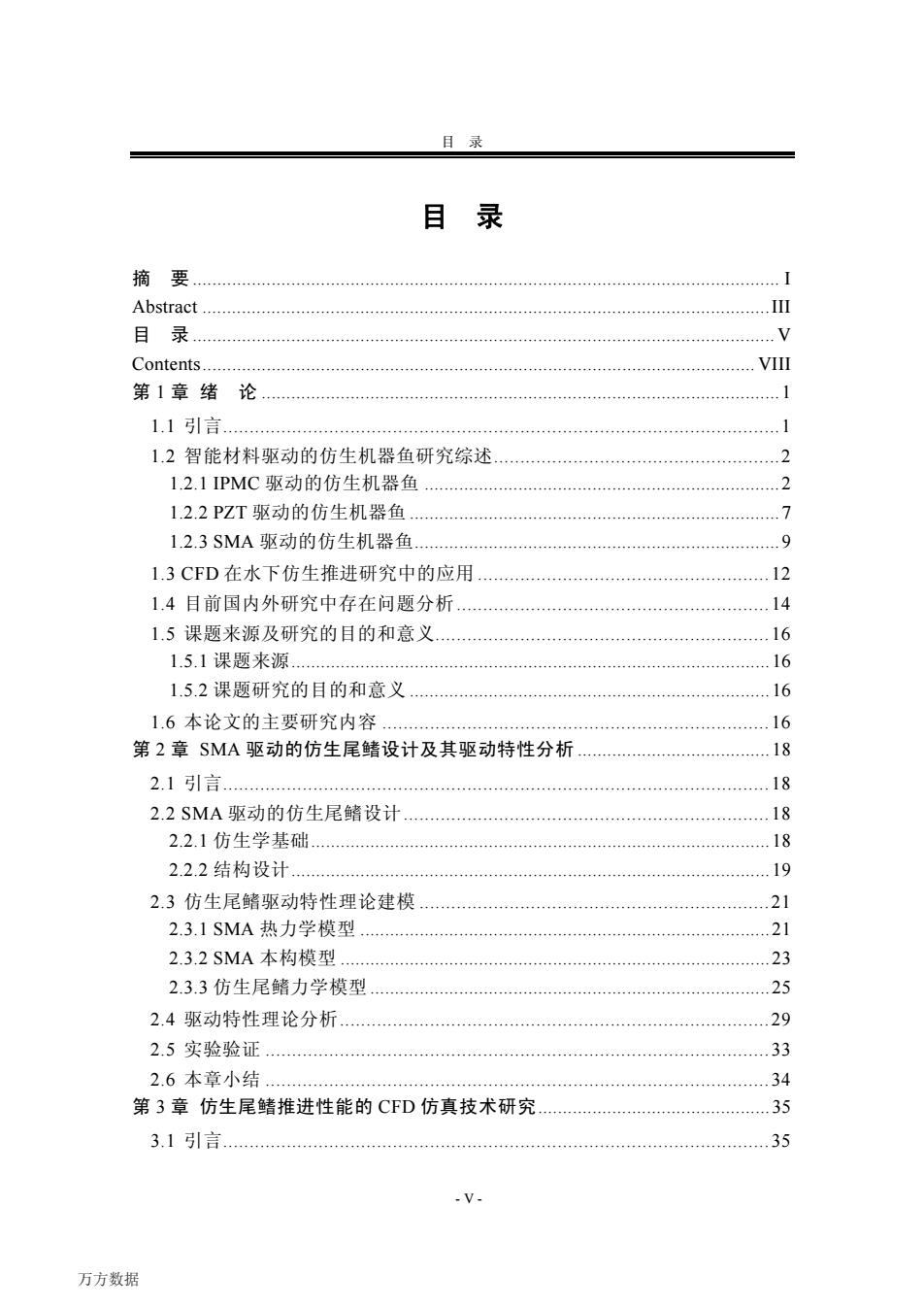
目录 目录 摘要 Abstract.… I 目录 N Contents...... VIII 第1章绪论 1.1引言. 1.2智能材料驱动的仿生机器鱼研究综述 .2 1.2.1IPMC驱动的仿生机器鱼 2 1.2.2PZT驱动的仿生机器鱼 7 1.2.3SMA驱动的仿生机器鱼 9 L.3CFD在水下仿生推进研究中的应用 12 1.4目前国内外研究中存在问题分析 14 1.5课题来源及研究的目的和意义 16 1.5.1课题来源 16 1.5.2课题研究的目的和意义 16 1.6本论文的主要研究内容 16 第2章SMA驱动的仿生尾鳍设计及其驱动特性分析 18 2.1引言… 18 2.2SMA驱动的仿生尾鳍设计 18 2.2.1仿生学基础 18 22.2结构设计 19 2.3仿生尾鳍驱动特性理论建模 21 2.3.1SMA热力学模型 21 2.3.2SMA本构模型 23 233仿生尾鳍力学模型 25 2.4驱动特性理论分析 29 2.5实验验证 33 2.6本章小结 34 第3章仿生尾鳍推进性能的CFD仿真技术研究 35 3.1引言. 35 -V. 万方数据
目 录 - V - 目 录 摘 要 ....................................................................................................................... I Abstract ...................................................................................................................III 目 录 ...................................................................................................................... V Contents................................................................................................................ VIII 第 1 章 绪 论 .........................................................................................................1 1.1 引言.........................................................................................................1 1.2 智能材料驱动的仿生机器鱼研究综述......................................................2 1.2.1 IPMC 驱动的仿生机器鱼 ........................................................................2 1.2.2 PZT 驱动的仿生机器鱼 ...........................................................................7 1.2.3 SMA 驱动的仿生机器鱼..........................................................................9 1.3 CFD 在水下仿生推进研究中的应用 .......................................................12 1.4 目前国内外研究中存在问题分析...........................................................14 1.5 课题来源及研究的目的和意义...............................................................16 1.5.1 课题来源.................................................................................................16 1.5.2 课题研究的目的和意义 .........................................................................16 1.6 本论文的主要研究内容 .........................................................................16 第 2 章 SMA 驱动的仿生尾鳍设计及其驱动特性分析 .......................................18 2.1 引言.......................................................................................................18 2.2 SMA 驱动的仿生尾鳍设计.....................................................................18 2.2.1 仿生学基础.............................................................................................18 2.2.2 结构设计.................................................................................................19 2.3 仿生尾鳍驱动特性理论建模 ..................................................................21 2.3.1 SMA 热力学模型 ...................................................................................21 2.3.2 SMA 本构模型 .......................................................................................23 2.3.3 仿生尾鳍力学模型 .................................................................................25 2.4 驱动特性理论分析.................................................................................29 2.5 实验验证 ...............................................................................................33 2.6 本章小结 ...............................................................................................34 第 3 章 仿生尾鳍推进性能的 CFD 仿真技术研究...............................................35 3.1 引言.......................................................................................................35 万方数据
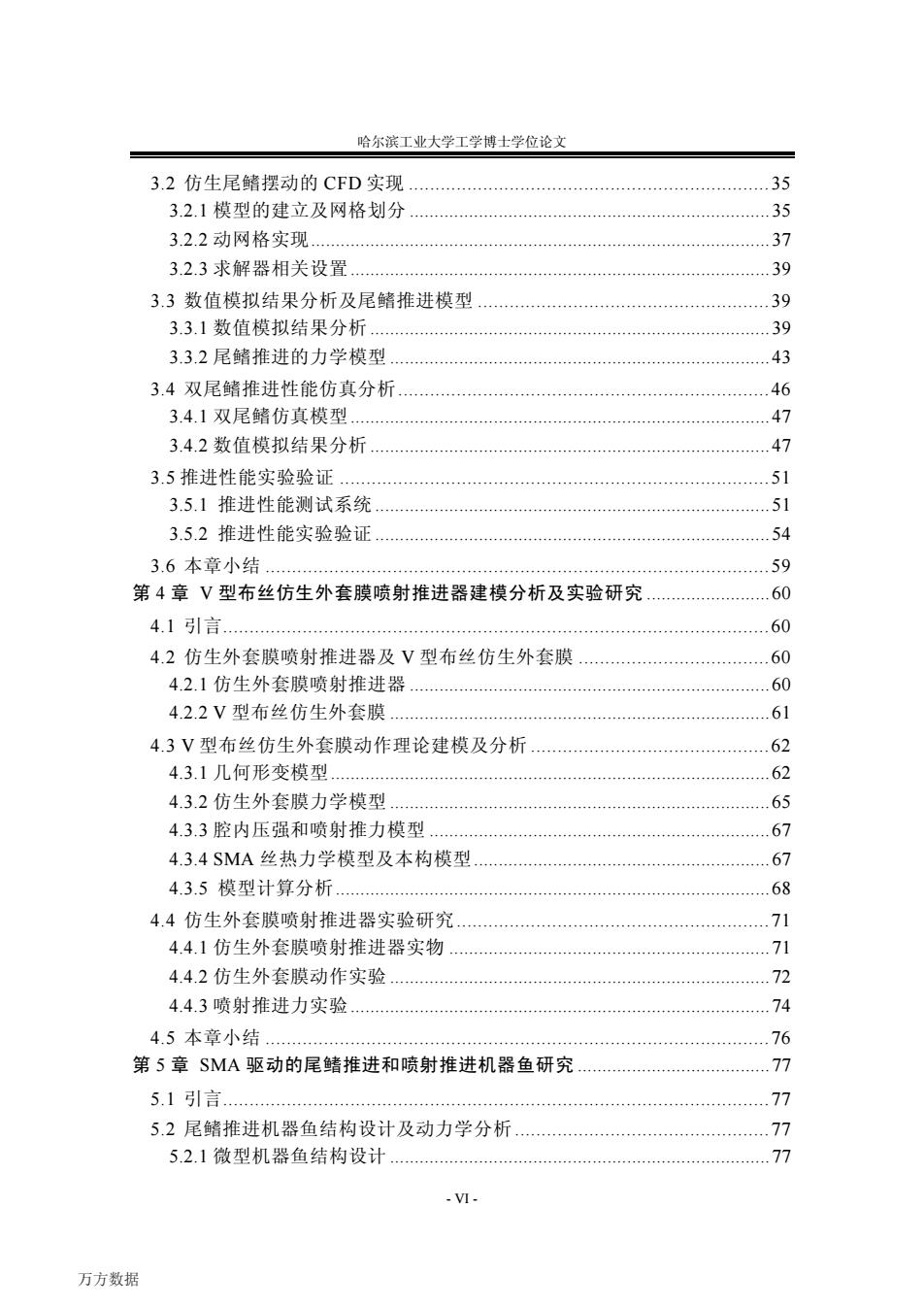
哈尔滨工业大学工学博士学位论文 3.2仿生尾鳍摆动的CFD实现 35 3.2.1模型的建立及网格划分 35 3.2.2动网格实现 37 3.2.3求解器相关设置 39 3.3数值模拟结果分析及尾鳍推进模型 39 3.3.1数值模拟结果分析 39 3.3.2尾鳍推进的力学模型 43 3.4双尾鳍推进性能仿真分析 。。。。。。。 46 3.4.1双尾鳍仿真模型 47 3.4.2数值模拟结果分析. 47 3.5推进性能实验验证 51 3.5.1推进性能测试系统 51 3.5.2推进性能实验验证… 54 3.6本章小结 59 第4章V型布丝仿生外套膜喷射推进器建模分析及实验研究… 60 4.1引言… 60 4.2仿生外套膜喷射推进器及V型布丝仿生外套膜 60 4.2.1仿生外套膜喷射推进器 60 4.2.2V型布丝仿生外套膜 61 4.3V型布丝仿生外套膜动作理论建模及分析 62 4.3.1几何形变模型 62 4.3.2仿生外套膜力学模型 65 4.3.3腔内压强和喷射推力模型 67 4.3.4SMA丝热力学模型及本构模型 67 4.3.5模型计算分析… 68 4.4仿生外套膜喷射推进器实验研究 71 4.4.1仿生外套膜喷射推进器实物 71 4.4.2仿生外套膜动作实验 72 4.4.3喷射推进力实验 74 4.5本章小结.… 76 第5章SMA驱动的尾鳍推进和喷射推进机器鱼研究 77 5.1引言.. 77 5.2尾鳍推进机器鱼结构设计及动力学分析 77 5.2.1微型机器鱼结构设计..… 77 -VI. 万方数据
哈尔滨工业大学工学博士学位论文 - VI - 3.2 仿生尾鳍摆动的 CFD 实现 ....................................................................35 3.2.1 模型的建立及网格划分 .........................................................................35 3.2.2 动网格实现.............................................................................................37 3.2.3 求解器相关设置.....................................................................................39 3.3 数值模拟结果分析及尾鳍推进模型 .......................................................39 3.3.1 数值模拟结果分析 .................................................................................39 3.3.2 尾鳍推进的力学模型 .............................................................................43 3.4 双尾鳍推进性能仿真分析......................................................................46 3.4.1 双尾鳍仿真模型.....................................................................................47 3.4.2 数值模拟结果分析 .................................................................................47 3.5 推进性能实验验证 .................................................................................51 3.5.1 推进性能测试系统 ................................................................................51 3.5.2 推进性能实验验证 ................................................................................54 3.6 本章小结 ...............................................................................................59 第 4 章 V 型布丝仿生外套膜喷射推进器建模分析及实验研究 .........................60 4.1 引言.......................................................................................................60 4.2 仿生外套膜喷射推进器及 V 型布丝仿生外套膜 ....................................60 4.2.1 仿生外套膜喷射推进器 .........................................................................60 4.2.2 V 型布丝仿生外套膜 .............................................................................61 4.3 V 型布丝仿生外套膜动作理论建模及分析 .............................................62 4.3.1 几何形变模型.........................................................................................62 4.3.2 仿生外套膜力学模型 .............................................................................65 4.3.3 腔内压强和喷射推力模型 .....................................................................67 4.3.4 SMA 丝热力学模型及本构模型............................................................67 4.3.5 模型计算分析........................................................................................68 4.4 仿生外套膜喷射推进器实验研究...........................................................71 4.4.1 仿生外套膜喷射推进器实物 .................................................................71 4.4.2 仿生外套膜动作实验 .............................................................................72 4.4.3 喷射推进力实验.....................................................................................74 4.5 本章小结 ...............................................................................................76 第 5 章 SMA 驱动的尾鳍推进和喷射推进机器鱼研究 .......................................77 5.1 引言.......................................................................................................77 5.2 尾鳍推进机器鱼结构设计及动力学分析 ................................................77 5.2.1 微型机器鱼结构设计 .............................................................................77 万方数据
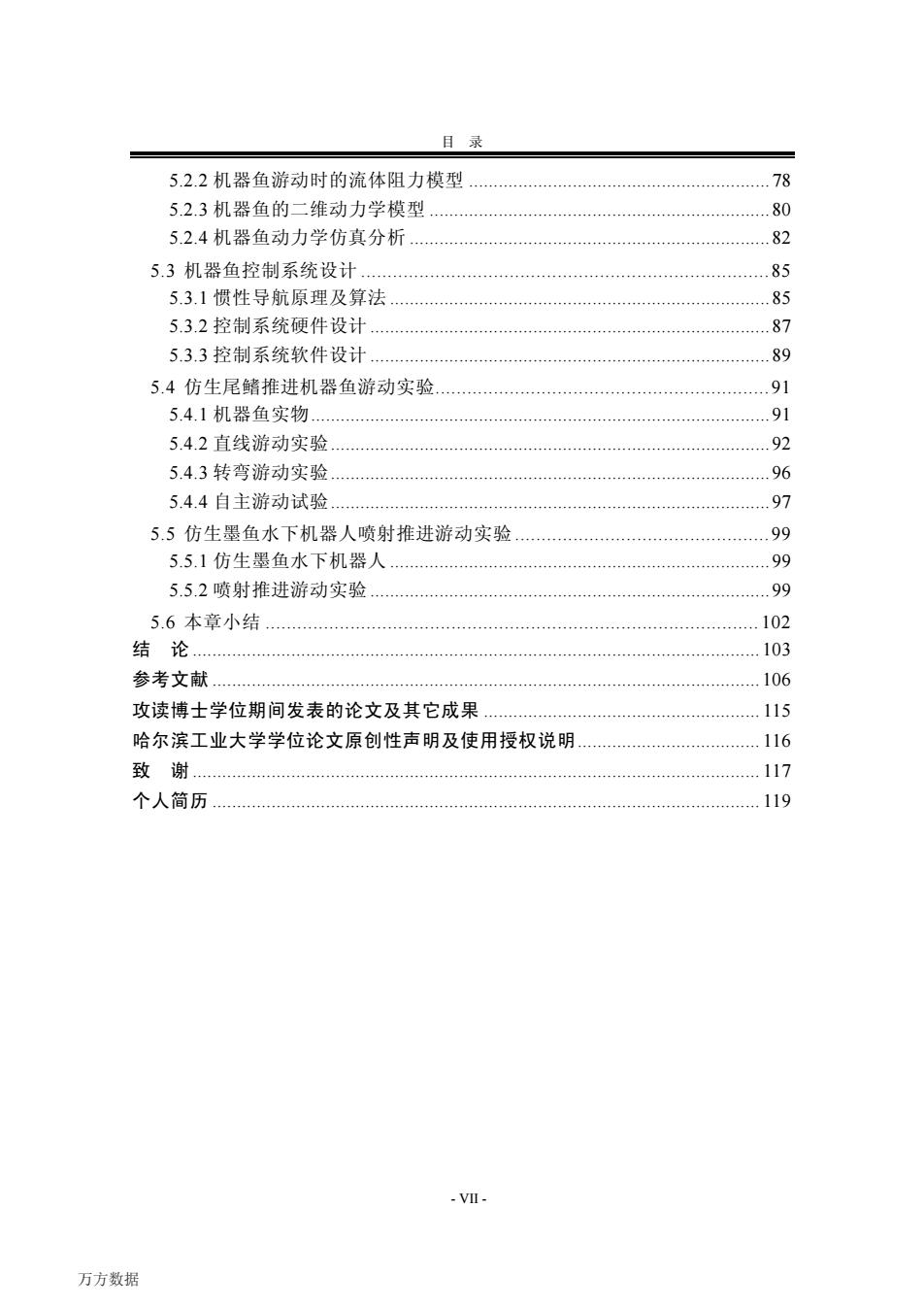
目录 5.2.2机器鱼游动时的流体阻力模型 78 5.2.3机器鱼的二维动力学模型 。, 。。。。,。。。。。。。。。。。。。。, 80 5.2.4机器鱼动力学仿真分析 82 5.3机器鱼控制系统设计 85 5.3.1惯性导航原理及算法 85 5.3.2控制系统硬件设计 87 5.3.3控制系统软件设计 89 5.4仿生尾鳍推进机器鱼游动实验 91 5.4.1机器鱼实物 91 5.4.2直线游动实验 92 5.4.3转弯游动实验 96 5.4.4自主游动试验 97 5.5仿生墨鱼水下机器人喷射推进游动实验 99 5.5.1仿生墨鱼水下机器人 99 5.5.2喷射推进游动实验 99 5.6本章小结 102 结论. 103 参考文献 106 攻读博士学位期间发表的论文及其它成果 115 哈尔滨工业大学学位论文原创性声明及使用授权说明 .116 致谢 .117 个人简历… .119 万方数据
目 录 - VII - 5.2.2 机器鱼游动时的流体阻力模型 .............................................................78 5.2.3 机器鱼的二维动力学模型 .....................................................................80 5.2.4 机器鱼动力学仿真分析 .........................................................................82 5.3 机器鱼控制系统设计 .............................................................................85 5.3.1 惯性导航原理及算法 .............................................................................85 5.3.2 控制系统硬件设计 .................................................................................87 5.3.3 控制系统软件设计 .................................................................................89 5.4 仿生尾鳍推进机器鱼游动实验...............................................................91 5.4.1 机器鱼实物.............................................................................................91 5.4.2 直线游动实验.........................................................................................92 5.4.3 转弯游动实验.........................................................................................96 5.4.4 自主游动试验.........................................................................................97 5.5 仿生墨鱼水下机器人喷射推进游动实验 ................................................99 5.5.1 仿生墨鱼水下机器人 .............................................................................99 5.5.2 喷射推进游动实验 .................................................................................99 5.6 本章小结 .............................................................................................102 结 论 ...................................................................................................................103 参考文献 ...............................................................................................................106 攻读博士学位期间发表的论文及其它成果 ........................................................ 115 哈尔滨工业大学学位论文原创性声明及使用授权说明..................................... 116 致 谢 ................................................................................................................... 117 个人简历 ............................................................................................................... 119 万方数据
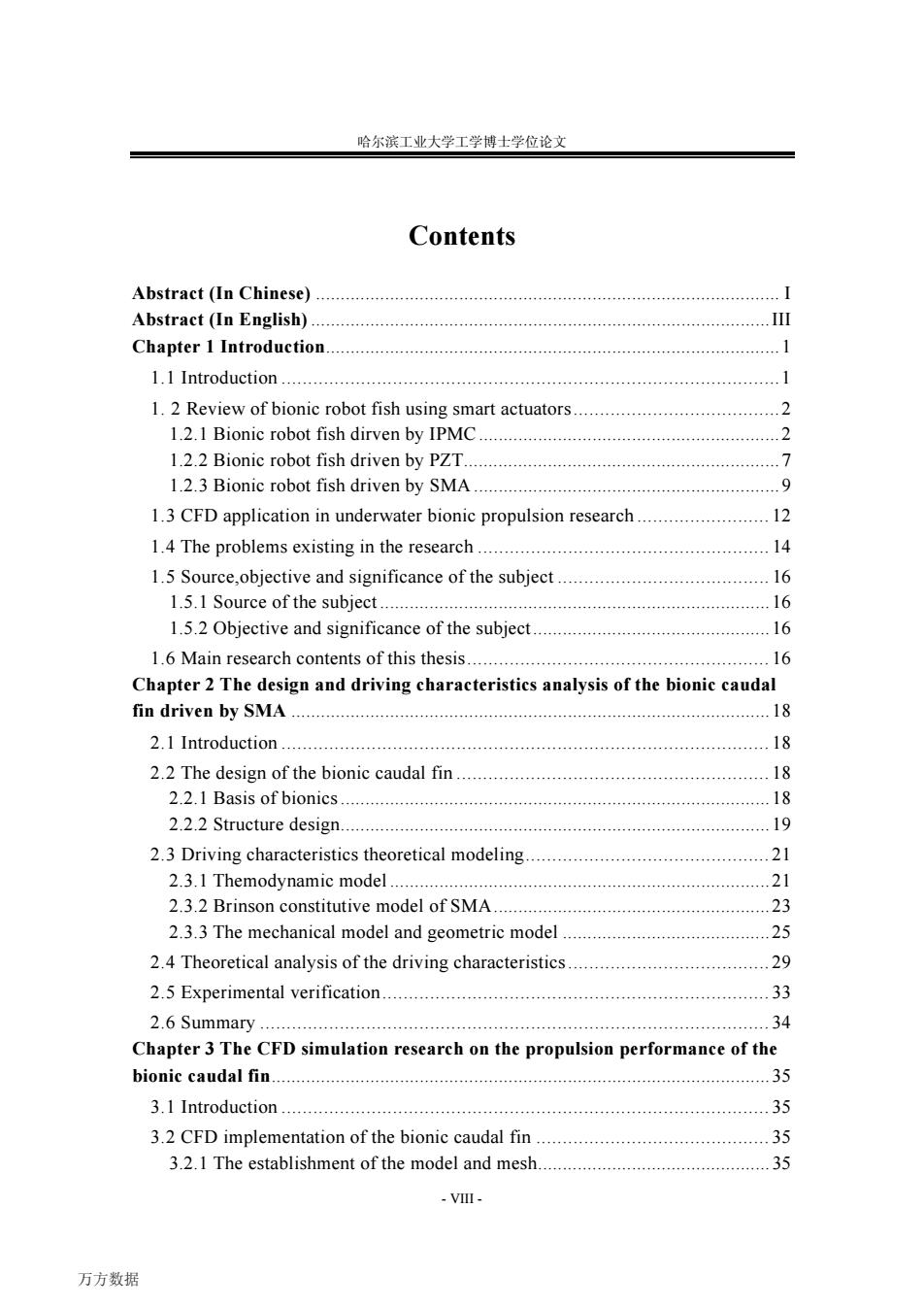
哈尔滨工业大学工学博士学位论文 Contents Abstract(In Chinese) Abstract(In English) I11 Chapter 1 Introduction .1 1.1 Introduction.… 1 1.2 Review of bionic robot fish using smart actuators.......................... 2 1.2.1 Bionic robot fish dirven by IPMC .2 1.2.2 Bionic robot fish driven by PZT........................... 7 1.2.3 Bionic robot fish driven by SMA 9 1.3 CFD application in underwater bionic propulsion research 12 1.4 The problems existing in the research.............. 14 1.5 Source,objective and significance of the subject.................. 16 1.5.I Source of the subject. 16 1.5.2 Objective and significance of the subject....................... 16 1.6 Main research contents of this thesis.......... 16 Chapter 2 The design and driving characteristics analysis of the bionic caudal fin driven by SMA 18 2.1 Introduction........... 18 2.2 The design of the bionic caudal fin. 18 2.2.1 Basis of bionics.. 18 2.2.2 Structure design................. 19 2.3 Driving characteristics theoretical modeling 21 2.3.1 Themodynamic model.......... 21 2.3.2 Brinson constitutive model of SMA...... 23 2.3.3 The mechanical model and geometric model ................................. 25 2.4 Theoretical analysis of the driving characteristics 29 2.5 Experimental verification.. 33 2.6 Summary........ 34 Chapter 3 The CFD simulation research on the propulsion performance of the bionic caudal fin 35 3.1 Introduction.... 35 3.2 CFD implementation of the bionic caudal fin 35 3.2.1 The establishment of the model and mesh......................... .35 -vIlI- 万方数据
哈尔滨工业大学工学博士学位论文 - VIII - Contents Abstract (In Chinese) .............................................................................................. I Abstract (In English) .............................................................................................III Chapter 1 Introduction............................................................................................1 1.1 Introduction ..............................................................................................1 1. 2 Review of bionic robot fish using smart actuators.......................................2 1.2.1 Bionic robot fish dirven by IPMC.............................................................2 1.2.2 Bionic robot fish driven by PZT................................................................7 1.2.3 Bionic robot fish driven by SMA ..............................................................9 1.3 CFD application in underwater bionic propulsion research ......................... 12 1.4 The problems existing in the research ....................................................... 14 1.5 Source,objective and significance of the subject ........................................ 16 1.5.1 Source of the subject ...............................................................................16 1.5.2 Objective and significance of the subject................................................16 1.6 Main research contents of this thesis......................................................... 16 Chapter 2 The design and driving characteristics analysis of the bionic caudal fin driven by SMA .................................................................................................18 2.1 Introduction ............................................................................................ 18 2.2 The design of the bionic caudal fin ........................................................... 18 2.2.1 Basis of bionics .......................................................................................18 2.2.2 Structure design.......................................................................................19 2.3 Driving characteristics theoretical modeling.............................................. 21 2.3.1 Themodynamic model .............................................................................21 2.3.2 Brinson constitutive model of SMA........................................................23 2.3.3 The mechanical model and geometric model ..........................................25 2.4 Theoretical analysis of the driving characteristics ...................................... 29 2.5 Experimental verification......................................................................... 33 2.6 Summary ................................................................................................ 34 Chapter 3 The CFD simulation research on the propulsion performance of the bionic caudal fin.....................................................................................................35 3.1 Introduction ............................................................................................ 35 3.2 CFD implementation of the bionic caudal fin ............................................ 35 3.2.1 The establishment of the model and mesh...............................................35 万方数据